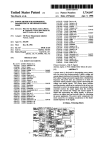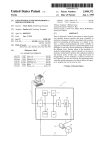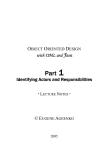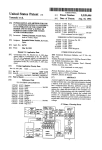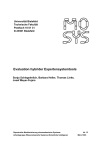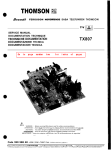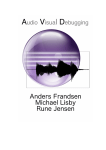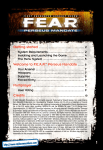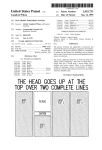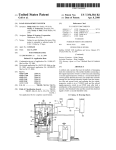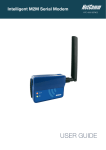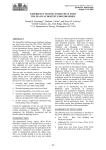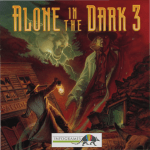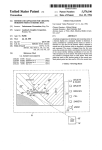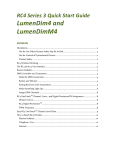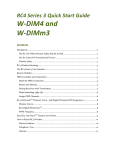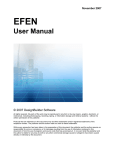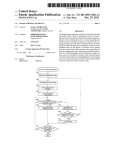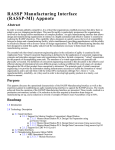Download Method and apparatus for automatic generation of object oriented
Transcript
lllllllllllllllllllllllllllllllllllllllllllllllIlllllllllllllllllllllllllll US005499371A Unlted States Patent [19] [11] Patent Number: Henninger et a]. [45] Date of Patent: [54] METHOD AND APPARATUS FOR 5,426,780 AUTOMATIC GENERATION OF OBJECT ORIENTED CODE FOR MAPPING RELATIONAL DATA TO OBJECTS 5,499,371 Mar. 12, 1996 6/1995 Gerull et a1. .......................... .. 395/600 OTHER PUBLICATIONS db+[-User’s Manual (Feb. 17, 1992) from Rogue Wave. [75] Inventors: Derek P. Henninger, Cupertino; Primary Examiner_K‘?vin A‘ Kriess Richard H_ Jensen’ Redwood City; Christopher T. Keene, San Francisco, all of Calif- Attorney, Agent, or Fzrm—Townsend and Townsend and Crew; Kenneth R‘ Allen [57] ABSTRACT [73] Assignee: Persistence Software, Inc., San Mateo, Calif, A method and apparatus are provided for using an object model of an object-oriented application to automatically [21] APPL No; 409,476 map information between an obj cot-oriented application and a structured database, such as a relational database. This is done by taking into account all of the semantics (implica [22] Filedi M311 22, 1995 _ tions) of an object model, such as inheritance and relation ships among object classes, and using these semantics to Related US. Application Data generate a minimal set of routines for each object class that manipulate the object and other objects to which it is related [63] Continuation of Ser. No. 95,322, Jul. 21, 1993, abandoned. [51] [52] Int. c1.6 ............................. .. G06F 9/44; G06F 15/40 US. Cl. ........................ .. 395/700; 395/600; 364/280; 364/28Q4; 364/2821; 364/2814; 364/DIG_ 1 erated using the method encapsulate all the details Of data [58] Field Of Search ................................... .. 395/600, 650, has“ access’ Such that devehpers (cOmPuter Pmgrammers) or from which it inherits. The generated routines, when executed, provide transparent access to relational data or Other ?eld-delimited data- Object classes and “mines gen 395/700 500 can write object~oriented applications using those object ’ [56] classes without any explicit reference to or knowledge of the References Cited 4 930 071 underlying database or its structure. By working with the objects, the user of such applications transparently manipu U.S. PATENT DOCUMENTS 5,1990 To“ et al 5:235:701 8/1993 0mm. et 5,291,583 3/1994 Bapat .................................... .. 395/500 5,295,256 3/1994 5,297,279 3/1994 Bannon et a1. ....................... .. 395/600 Bapat lates the database without needing to know anything of its structure. Applications can be written using the object 364/300 """""""""""""" " . . ... .. ... .. . . . .. classes to transparently integrate information from multiple databases 395/500 30 Claims, 11 Drawing Sheets r20 _ , r2 OBJECT [4-30 DATABASE / MODEL SCHEMA r50 TRANSFORM MEMORY 3 '_‘\ ‘ STORAGE DEVICE [ ‘ [ ' PROCESSOR METHOD /15 SOFTWARE 11 V GUI \ 5 DATABASE f7 NETWORK .. K“ 9 v f 1o [' PROCESSOR DATABASE v / SOURCE P CODE 12 US. Patent Mar. 12, 1996 Sheet 1 of 11, r20 Kso OBJECT K2 5,499,371 r50 DATABASE / MODEL / / SCHEMA / /TRANSFORM7 / MEMORY 3X f1 STORAGE DEVICE " L PROCESSOR ‘ GUI " \ 15 METHOD / SOFTWARE 7 NETWORK / 5 r9 , ‘ DATABASE DATABASE K10 ‘ ' PROCESSOR “ SOURCE 7 CODE 12 ; FIG. 1 ACCEPT OBJECT /A MODEL (20) B YES EXISTING _ DATABASE C\ v I I r0 ACCEPT DATABASE SCI-IEMA (so) AND TRANSFORM (50) CONSTRUCT DATABASE SCHEMA (30) AND TRANSFORM (so) I | F\ WRITE ROUTINE To CREATE OBJECT INSTANCE G\ I WRITE ROUTINE TO E\ LOOP FOR EACH OBJECT __ CLASS IN OBJECT MODEL H I \ WRITE ROUTINE TO UPDATE OBJECT INSTANCE J} WRITE ROUTINE TO DELETE OBJECT INSTANCE I .. WRITE OBJECT CLASS /K ROUTINES TO EXTERNAL STORAGE _T__—| EXCLUDE CODE (OPTIONAL) _ RETRIEvE OBJECT INSTANCE / SOURCE CODE FIG. 3 K12 __ US. Patent Mar. 12, 1996 Sheet 3 of 11 5,499,371 K DA LOOP FOR EACH OBJECT MODEL SEMANTIC ELEMENT ‘_/ OBJECT MODEL (20) / DC \ CLASS ADD TABLE TO DATABASE SCHEMA ~_ ADD TRANSFORM BETWEEN CLASS AND TABLE DD\ ATTRIBUTE : ADD COLUMN TO TABLE ASSOCIATED W CLASS ADD TRANSFORM BETWEEN ATTR AND COLUMN INHERTIANCE DE \ (HORIZONTAL) L ADD PARENT COLUMNS TO CHILD TABLE D; ADD TRANSFORM FOR ATTRIBUTES INHERITANCE (VERTICAL) \ ADD FOREIGN KEY COLUMNS TO CHILD TABLE ' ADD TRANSFORM MAP CHILD FKEYS TO PARENT RELATIONSHIP DG\ (1-TO-1,1-TO-MANY1 ADD FKEY COLUMNS TO APPROPRIATE TABLE DH ' ADD TRANSFORM MAP FKEYS TO RELATED CLASS RELATIONSHIP ADD JOIN TABLE TO SCHEMA (MANY-TO-MANY) ADD FOREIGN KEY COLUMNS TO JOIN TABLE ADD TRANSFORM MAP FOREIGN KEY COLUMNS TO OBJECT ID ATTRIBUTES FOR RELATED CLASSES I D‘ \ WRITE ROUTINE TO CREATE PHYSICAL DATABASE ACCORDING TO SCHEMA CREATE DB I DJ \ MAKE SCHEMA AND TRANSFORM AVAILABLE FOR FURTHER PROCESSING I DATABASE I / SCHEMA(30) / / I TRANSFORM (50) FIG. 4 / ROUTINE TO / / US. Patent Mar. 12, 1996 Sheet 5 of 11 5,499,371 US. Patent Mar. 12, 1996 Sheet 6 of 11 5,499,371 Oh.OEmm fAi i U.S. Patent .2(w0@mE Mar. 12, 1996 Sheet 7 0f 11 5,499,371 US. Patent 2.(N0GmE Mar. 12, 1996 Sheet 9 of 11 5,499,371 US. Patent Mar. 12, 1996 Sheet 11 of 11 5,499,371 5,499,371 1 2 METHOD AND APPARATUS FOR AUTOMATIC GENERATION OF OBJECT ORIENTED CODE FOR MAPPING RELATIONAL DATA TO OBJECTS “tire.” The tire class can have attributes, such as “pressure”; relationships, such as “tire” is related to an “axle”; and inheritances, such as a “snow tire” inherits from a “tire.” The difference between a relational database management This is a continuation of application Ser. No. 08/095,322 ?led Jul. 21, 1993, now abandoned. an object “knows” what operations can be performed on its data, whereas an RDBMS only has a set of generic opera tions which can be performed on its tuples. The semantics system (RDBMS) and an object-oriented application is that COPYRIGHT NOTIFICATION available in an object model are not preserved in a relational 10 A portion of the disclosure of this patent document contains material which is subject to copyright protection. to an “axle” and inherits from a “tire.” In contrast, a relational database represents this information in three sepa rate data tables with no explicit representation of the rela tionships between the tables. The tire table in a relational The copyright owners have no objection to the facsimile reproduction, by anyone, of the patent document or the patent disclosure, as it appears in the patent and trademark office patent ?le or records, but otherwise reserve all copy database might have foreign key information referring to the axle table, but this representation of the relationship between right rights whatsoever. MICROFICHE APPENDICES Two appendices comprising a total of 1444 frames on 16 micro?che are included as part of this application. Appendix database. For example, a “snow tire” knows that it is related 20 tire and axle is implicit. It is up to the developer to know about these relationships, what they mean, and how to handle them. There is a desire to build object-oriented applications that store and access data found in relational databases. For I contains the source code of PersistenceTM version 1.3 example, it would be useful to employ a plan for an released Jun. 15, 1993. It comprises 1358 frames on 14 micro?che. The PersistenceTM software represents an embodiment of the method of the present invention. Appen automobile (an object model) to build a vehicle (an object) from an organized inventory of auto parts (a relational 25 dix H contains a user’ s manual for PersistenceTM version 1.2 released March 1993. It comprises 100 frames on 2 micro~ ?che. The source code in Appendix I represents unpublished 30 database). A system is needed which can map information between a database and an obj ect-oriented application based on the semantics of an object model. More particularly, what is needed is a mechanism for using the semantic elements of an object model to generate routines that map data between a database and an object-oriented application. work, Copyright@ 1993 Persistence Software, Inc. All rights reserved. The user’s manual in Appendix H is Copyright@ 1993 Persistence Software, Inc. All rights reserved. For both Appendices I and II, copyright protection claimed includes Systems are known for manual mapping between objects in knowledge bases and database management systems. One screen such as icons, screen display looks, etc. No. 4,930,071 issued May 29, 1990 and assigned to Intel liCorp, Inc. of Mountain View, Calif. In static-type systems, approach is to employ a static class library as an interface all forms and matters of copyrightable material and infor 35 between an object-oriented system and a relational database. An example is METHOD FOR INTEGRATING A mation now allowed by statutory or judicial law or hereafter KNOWLEDGE-BASED SYSTEM WITH AN ARBI granted, including without limitation, material generated TRARY RELATIONAL DATABASE SYSTEM, US. Pat. from the software programs which are displayed on the objects can be extended to handle concepts such as relation BACKGROUND OF THE INVENTION ships and inheritance, but they must be manually extended The invention relates to the interrelationship of databases, if they are to model complex real world structures. This particularly relational databases, and object-oriented sys limits their usefulness to building relatively simple object tems. More particularly, the invention relates to relationships models from existing data, such as those used in rapidly building prototype systems. It is believed that there are commercial systems which use the static-type class between objects in object-oriented systems and descriptions of objects storable in ?eld-delimited database structures. Field~delimited databases can structure data into ?elds approach. Among the candidates include “ProKappa” from IntelliCorp, “DB.H++” from Rogue Wave of Corvallis, Greg, and possibly “Open ODB” from Hewlett Packard Company of Cupertino, Calif. and “UniSQL from UniSQL which have common attributes. For example, relational databases can structure data into tables, each with columns and rows (in “n” dimensions) forming tuples, upon which certain operations in set algebra can be performed very of Austin, Tex. conveniently. Object-oriented applications organize data and routines together into encapsulated units referred to as objects. Object-oriented applications lead to modular software sys tems which have increased ?exibility and are easy to alter and maintain. An object model is a formal description of an object oriented application. The semantic elements of an object 55 SUMMARY OF THE INVENTION According to the invention, a method and apparatus are provided for using an object model of an object-oriented application to automatically map information between an object-oriented application and a structured database, such 60 as a relational database. This is done by taking into account model describe object classes, attributes of object classes, relationships between object classes, and inheritance all of the semantics (implications) of an object model, such as inheritance and relationships among object classes, and between object classes. An object model provides a power ful mechanism to represent the real world, for example because objects carry information about inherited charac using these semantics to generate a minimal set of routines for each object class that manipulate the object and other 65 objects to which it is related or from which it inherits. The teristics and relationships with other objects. For example, generated routines, when executed (that is, when converted an object model of a car can contain many classes, such as to an executable form which is then executed), provide 5,499,371 3 4 transparent access to relational data or other ?eld-delimited An “object class” is a set of data (attributes) and func tional capabilities (routines) encapsulated into a single logi cal entity. For example, an employee class may be charac terized by a telephone number attribute and a data. Object classes and routines generated using the method encapsulate all the details of database access, such that developers (computer programmers) can write object-ori ented applications using those object classes without any “hirelsemployee” routine. explicit reference to or knowledge of the underlying data base or its structure. By working with the objects, the user an object class. Instances are differentiated from one another of such applications transparently manipulates the database by their attribute values, but not their routines (capabilities). without needing to know anything of its structure. Applica tions can be written using the object classes to transparently An “object instance” is an embodiment (instantiation) of 10 integrate information from multiple databases. The method of the invention comprises accepting a user de?ned object model as a “blueprint” for an object-oriented application; accepting or constructing a schema of the structure of data in a database; and accepting or constructing a transform de?ning the mapping between the database schema and the object model. Based on these inputs the method automatically generates source code routines for each object class to perform four tasks: to create, retrieve, update, and delete instances of the object class and auto An “object-oriented application” is an operational com puter program which when employed on an appropriate computer system uses a set of object instances that work in cooperation to perform useful work. For example, an obj ect oriented application could be built to manage personnel records for a company, including such operations as hire 20 accompanying drawings. new employee or add an employee to a department. An “object model” is a set of object classes that together form a blueprint for building an object-oriented application. matically make the corresponding changes in the database. These source code routines can subsequently be executed. The invention will be better understood by reference to the following detailed description in connection with the For example, Jane Smith may be a ?rst person-object instance and John Doe may be a second person-object instance. The term “object” is often used by itself to refer loosely to either an object class or an object instance, the difference being understood in context. Each object class of an object model can have attributes, inheritances, and relationships. 25 A “relationship” de?nes a link between two object classes. For example, an employee class may be related to the department class Each speci?c employee for example, BRIEF DESCRIPTION OF THE DRAWINGS “Jane Smith,” would have a relationship with a speci?c department, such as “engineering.” Relationships can be FIG. 1 is a block diagram of a computer system in 30 one-to-one, one-to-many, or many-to-many. An example of accordance with the invention. a one-to—one relationship can be a relationship between FIG. 2 is a schematic diagram representing the correspon employee and parking place such that each employee can dence between a database schema and an object model by have a single parking place. An example of a one-to-many means of a transform. relationship can be a relationship between department and FIG. 3 is a ?ow chart representing an overview of the 35 employee such that each department can employ multiple method steps. employees. An example of a many-to-many relationship can be a relationship between employee and project such that each employee serves on multiple projects, and each project FIG. 4 is a ?ow chart representing the process for con structing the database schema and transform. FIG. 5 is a ?ow chart representing the process for writing consists of multiple employees. code which when executed creates an object instance and its 40 corresponding structured information in the database. FIG. 6 is a ?ow chart representing the process for writing code which when executed retrieves an object instance base on its corresponding structured information in the database. FIG. 7 is a ?ow chart representing the process for writing “Attributes” are data elements of object classes which are expressed through particular values in object instances. For example, a person class can have the attribute “name”, and a particular person instance can have the name value “Jane Smith.” 45 An “object ID” is used to uniquely identify each object instance. The object ID can generated in one of two ways. code which when executed updates an object instance and its corresponding structured information in the database. FIG. 8 is a How chart representing the process for writing code which when executed deletes an object instance and makes corresponding changes to structured information in the database. It can be generated by the application, which can automati cally assign a unique object ID for each new object instance. Alternatively it can comprise a set of attributes that are guaranteed in the object model to always form a unique set of values for an instance. In this case, the create routine will require a unique set of attributes in order to create a new object instance. A “routine” is a functional capability associated with an DESCRIPTION OF A SPECIFIC EMBODIMENT 55 Following is a description of a speci?c embodiment of the method of the present invention. Section 1 sets forth termi nology that is used in the remainder of the description. Section 2 provides a description of a computing system that object class. For example, the routine “hiren employee” could be used to create a new employee instance. “Inheritance” represents a specialization of an object class in which the specialized class shares all of the attributes and routines of parent classes. Thus the employee class can can be used to support the steps of the method. Section 3 60 inherit certain attributes, such as name, from the person describes the inputs to the method. Section 4 describes an class. In this case, the person class is called the “parent” of overview of the method steps. Sections 5 and 6 give more the employee class, and the employee class is called the detailed descriptions of speci?c method steps. Section 7 “child” of the person class. concludes the description. Inheritance can extend across many object class “genera 1. Terminology 65 tions.” For example, the object class “snow tire” can inherit from the object class “tire” which in turn can inherit from the It is helpful to clarify the general meanings of terms used in connection with object-oriented systems. object class “car_ art”. In this example, “car_part” is a 5,499,371 5 6 parent of the object class “tire” and an ancestor of the object class “snow tire”. Inheritance can be “vertical” (concrete) or “horizontal” are illustrated as inputs to be accepted. Information about the object model 20 can be accepted using the processor 1 in conjunction with graphical user interface 5 or storage device (abstract) according to how the information corresponding 3 to input the object model. Information about the database to inherited attributes is stored in the database. In the case of 5 “person.” If this inheritance is vertical,‘ then there can be a “person” table in the database which contains the attributes for each “person”. If the inheritance is horizontal, there is no 15 schema 30 and transform 50 can be accepted in a like manner; alternatively, database schema 30 and transform 50 can be constructed by the method using processor 1. The method generates source code 12 representing code for each of the object classes in the object model 20 as output. This code, when converted to an executable form and executed, can create, retrieve, update, and delete object instances. Source code 12 can, for example, be output to storage device 3 or user interface 5, held in memory 2 and made available for further processing, or immediately or subsequently executed by processor 1 or another processor. are found in the “employeendata” table. Horizontal and vertical inheritance can be mixed within the same object model. FIG. 2 is a schematic diagram representing the correspon dence between the database schema 30 and the object model 20 by means of a transform 50 for an example object vertical inheritance between two object classes in an object model, the database contains data associated with each object class. In the case of horizontal inheritance between two object classes in the object model, the database does not contain data associated with each object class. For example, suppose that there are two object classes, “and that 10 “employee” inherits “person” and “employee” inherits from “person” table in the database. All the attributes of “person” The attributes, inheritances, and relationships of all the object classes of an object model are called the “semantics” or “semantic elements” of the object model. An object model contains certain information associated with its semantics. For each attribute, the object model contains information as to whether that attribute is to be associated with the object ID for the class. For each inheritance, the object model 3. Method Inputs 20 oriented application. According to the method of the invention, an object model‘ is used to describe the structure of an object-oriented appli 25 contains information as to whether the inheritance is vertical or horizontal (concrete or abstract). cation, including the structure of each object in the appli cation and the relationships and inhen'tances between objects. In FIG. 2, the object model 20 represents the structure of a personnel records management application. For purposes of this example‘, the object model 20 has three object classes: department class 101, employee class 105, For each relationship, the object model contains informa and person class 109. The object model 20 contains tion about a “delete action” associated with that relationship. 30 attributes 102, 103 for the department class 101; attributes ‘ The delete action speci?es what happens to object instances 106, 107 for the employee class 105; and attributes 110, 111 of a related class whenever an object instance of the given for the person class 109. The object model 20 also contains class is deleted. For example, if an object instance of the one relationship, called works_in (relationship example object class “department” is deleted, the delete action for the employee-department relationship can specify that the 35 employees of that department are to be deleted as well. For each relationship in the object model, referential integrity must be maintained in the corresponding database tables. Referential integrity requires that the foreign key columns for any particular row always refer to valid primary key columns in the related table. 2. System Overview FIG. 1 illustrates a digital computing system suitable to implement the method of the present invention in a typical embodiment. The system comprises computing hardware 104), and one inheritance, in which employee class 105 inherits from person class 109 (inheritance example 108). The works_in relationship expresses the idea that each department has some number of related employees that work in the department. The inheritance between employee class 105 and person class 109 expresses the idea that an 40 employee is a kind of person (that is, employee is a child class of person, and person is a parent class of employee). The object model 20 also contains information (not shown) about what attributes form the object ID for each class, 45 whether the inheritance between employee and person is vertical or horizontal, and what kind of delete action is and related system software that together support the execu tion of method software 15, which is software that carries out the steps of the method of the invention. More particu larly, the system of FIG. 1 comprises a processor 1 that is associated with the relationship between department and employee. In this example, employee class 105 inherits vertically from its parent, person class 109. software entity that is executed by processor 1, and network 7 is not present. It will be appreciated by those of skill in the each row in a table. Multiple primary key columns can also be used in combination to uniquely identify each row in the art that a wide range of computing system con?gurations can be used to support the method of the present invention table; an example is a combination of a ?rst name column 123 and a last name column 124 as in person table 122. including, for example, con?gurations that employ multiple Column 114 of the department table 113, column 117 of the employee table 116, and columns 123 and 124 of person table 122 are primary key columns. A foreign key column (or columns) can be employed to The database schema 30 for a ?eld-delimited database can coupled to a memory 2, a storage device 3 (such as a hard 50 be organized into tables, as in a relational database. As disk), and a user interface such as graphical user interface 5. shown in FIG. 2, an exemplary relational database com The processor 1 is also coupled to at least one database, in prises a department table 113, an employee table 116 and a this case to database 9 via network 7. In the illustrated person table 122. Within each table 113, 116, 122 are embodiment the database 9 has its own associated hardware columns that can be of three types: primary key, foreign key, including a database processor 10 that is distinct from 55 and data. processor 1. In other embodiments the database 9 is a A primary key column is employed to uniquely identify processors and multiple databases. Method software 15 makes use of certain components that are also shown in FIG. 1. Among these components are an object model 20, a database schema 30, and transform 50. Object model 20, database schema 30, and transform 50 are accepted or created at run time by the method. In FIG. 1 they 65 logically connect a row in a given table to a unique or speci?c row in another table. For example, column 121 in employee table 116 is a foreign key to column 114 of 5,499,371 7 8 department table 113, and columns 119 and 120 of employee conceptually distinct, can be combined or intertwined in some embodiments. Also it will be appreciated that in some table 116 are foreign keys to columns 123 and 124 of person table 122. A data column is employed to store information that is neither a primary key nor a foreign key. For example, location column 115 of department table 113 and sex column embodiments each of the routines generated during the loop can be implemented as a collection of smaller routines that perform subsets of the total functionality described here. After the loop (Step E) is complete the code generated during the loop is output (Step K). The code can be stored, typically in a storage device such storage device 3. Alter natively or additionally, it can be displayed via user interface The transform 50 describes a mapping between elements of the object model 20 and elements of the database schema 10 5 or made available via memory 2 to the processor 1 or via network 7 to another processor for further processing. 30. Speci?cally, the transform 50 describes four kinds of 118 of employee table 116 are data columns. Person table 122 has no data columns. mappings. First, there is the mapping between the attributes After the generated code is output, optionally this code that make up an object ID for an object instance and the primary key columns in one or more database tables. For (that is, an executable form of this code) can be executed (Step L). Custom code can be added to the generated code, run-time libraries can be linked in, and the resulting software can be run. Execution can be performed subsequently to code generation. Execution can be carried out by processor 1 or by another processor. 5. Constructing the Database Schema and Transform FIG. 4 illustrates in more detail the process for construct ing the database schema 30 and transform 50 when the schema and transform are not accepted from an external example the transform 50 maps the object ID attribute 102 to primary key column 114. Second, there is a mapping between an object class attribute in a object model and a column or colurrms in a database. For example, the trans form 50 maps attribute 107 to column 118. Third, there is the mapping between a relationship in an object model and a 20 foreign key column or columns in a database table. For example, the transform 50 maps relationship 104 to column 121. Fourth, there is the mapping between inheritance and a foreign key column or columns in a database. For example, source (Step D of FIG. 3). A loop (Step DA) is executed the transform 50 maps inheritance 108 to columns 119 and 25 repeatedly, once for each semantic element of the object model. A test is made of the semantic element (Step DB). If 120. 4. Method Overview The ?ow chart of FIG. 3 provides an overview of the operation of the method of the invention. The method accepts object model 20 and accepts or creates database schema 30 and transform 50. Using these three elements as the element de?nes a new class, a table is added to the input, the method automatically generates source code. More particularly, the method generates the object classes in object model 20. Each generated object class contains rou (Step DD). tines to create, retrieve, update, and delete instances of that object class. Each routine takes into account the full seman database schema, and a corresponding transform is added to map that table to its related class (Step DC). For each attribute in the object model, a column is added to the database table schema and a corresponding transform is added to map that database column to the class attribute 35 For vertical inheritance, attributes and relationships are associated with the class in which they were de?ned. For horizontal inheritance, attributes and relationship are asso ciated only with the lowest level child table of the database tics of the object model, including attributes, inheritances, schema. For each vertically inherited parent class, foreign and relationships in the object model. The method outputs key columns are added that refer to the parent table and a transform is created to map these foreign key columns to the the generated code as source code 12, which optionally can be converted to an executable form which can then be 40 class inheritance property (Step DF). It will be appreciated executed. The steps of the method are performed by processor 1 in conjunction with the other system components to which it is coupled. For example, processor 1 can act in conjunction with user interface 5 to accept object model 20, database 45 that these primary key columns of each child table can also serve as foreign key columns which point to the parent table. For each horizontally inherited parent class, the attributes and relationships of the parent class are added to the schema for the current class (Step DE). Alternatively, a type code schema 30,'and transform 50. As another example, processor column can be added to the table to di?erentiate between child classes. For each one-to-one and one-to-many relationship in the 1 can use storage device 3 to store the output source code 12, or can use network 7 to communicate the source code 12 to object model, a foreign key column or foreign key columns another processor also coupled to network 7. The ?rst step in the method is to accept an object model 50 are added to the database table schema in the appropriate table (Step DG). For each many-to-many relationship in the object model, a separate join table is added to the database schema (Step DH). This table contains foreign key refer 20 (Step A). Thereafter, if there is an existing database (Step B), the method accepts a database schema 30 and a trans form 50 from an external source (Step C). Otherwise, the method constructs a database schema 30 and a transform 50 derived from the object model 20 (Step D). Thereafter a loop (step E) comprising steps F, G, H, and J is executed repeatedly, once for each object class in the ences to each of the two related tables. In either case (that 55 is, for any relationship) a corresponding transfonn is also created to map the foreign key columns to the class rela tionship. Once the loop for all objects has been completed, con struction of the schema 30 and transform 50 is complete. object model, to generate source code routines to create (Step F), retrieve (Step G), update (Step H), and delete (Step J) instances of that object class. The code generated by this loop can, for example, be C++ code where each object class 60 Next the method writes a routine which, when converted to in the object model is represented as a C++ class and the generated source code routines are represented as C++ tured database corresponding to the database schema 30 routines (methods) associated with the class. Alternatively, any kind of general purpose programming language can be used to embody the code. It will be appreciated by those of skill in the art that the Steps F, G, H, and J, although an executable form which is then executed, creates a struc generated by the method (Step DI). Finally, the database schema 30 and transform 50 are made available for further 65 processing (Step DJ), for example, by writing the informa tion to storage device 3. 6. Details of Method Steps to Generate Routines 5,499,371 9 10 . For each class in the object model 20, the method gen erates a minimal set of operations to manipulate an object instance of the class and other object instances to which it is related or from which it inherits. More speci?cally, for each object class, four types of routines are written. These rou example, if each employee can have one car, it can be the case that a car table contains a foreign key which points to the employee table (e.g., the employee’s ID number), or it can be the case that the employee table contains a foreign key which points to the car table (e.g., the car’s license plate number). The transform 50 tells the method which of these tines provide the functions of creating, retrieving, updating, and deleting instances of that object class. For each routine the method iterates through the object model to draw out the implications of each object model semantic element for that routine and object class. In other words, the method looks through the object model and ?nds every semantic element in the object model——that is, every attribute, relationship, or two is in fact the case——or more generally, where the foreign 10 inheritancewthat needs to be considered in order to write this information when writing the routine. Once again, it will method generates code which when executed uses the object ID attributes of the related instance to set the foreign key column values for the instance being created (Step PC). If this class is on the “many” side of the relationship (e.g., a department can have many employees), the method writes be appreciated that in some embodiments each of the routines generated during the loop can be implemented as a collection of smaller routines that perform subsets of the total functionality described here. 20 code which when executed will update the foreign key for the related class to point to the primary key of the object instance being created (Step FN). If the relationship is many~to-many (Step FP), the method generates code that when executed sends a database insert 25 6.1 Steps to generate a routine to create an object instance The ?ow chart of FIG. 5 expands step F of FIG. 3 to provide additional detail. It illustrates the steps to generate a create routine for a particular object class (Step FA). The method performs a loop for each object model semantic element relevant to this class (Step FB). To ?nd these elements the method scans the entire object model and extracts semantics that de?ne the attributes, inheritances, and relationships for this class. Depending on the kind of semantic found (Step PC), the method generates code to re?ect the implications of the semantic in the create routine. is on-that is, whether this object class is on the “1” side or the “many” side of the relationship. If this class is on the “1” side of a one-to-many relationship (e.g., an employee can work in only one department), foreign key information for the relationship can be stored in this class. Accordingly, the the given routine for the given object class, and incorporates It will be appreciated that the method uses techniques similar to those used in a programming language compiler. In the method, however, the “programming language” com prises an object model and, optionally, a database schema and transform, and the output of the “compiler” is the source code that is generated. key information for a given relationship is stored. If the relationship is one-to-many (Step FM), the method determines which “side” of the relationship this object class 30 command to create a new row in the join table which connects the two related classes. This row will contain foreign key pointers to each of the two related instances. For example, if an employee is related to a project through a many-to-many relationship, this relationship will be created by adding a row to the assignment table which “points to” a particular employee and a particular project, thereby joining the two. 35 After all the semantic elements of the object model are interpreted, the method writes code which when executed will create an object instance of the given class in the object-oriented application (Step FQ). For example, in the For an object model semantic that de?nes an attribute of the GH- language, an instance is created which has all the class (Step FD), the method performs steps that depend on attributes de?ned in the object model, which has pointers or the kind of attribute. If the attribute is de?ned as being part arrays to represent its relationships and which uses built-in of the object ID (Step FG), the method writes code that when 40 language constructs to represent inheritance. Also, the executed (that is, when converted to an executable form method writes code that when executed will send an insert which is then executed) forms a query to the database to command or commands to the database to store in the ensure that the combination of primary key attributes de?ne database all the information for this new object instance a unique object instance. If the object model indicates that (Step FR). These database commands insert rows into the the object ID attribute is to be generated by the method (Step 45 database that correspond to the attribute values of the new FH), the method writes code that when executed will gen object instance and its parent instances. Further, these com erate automatically a unique primary key value for the object mands update rows in the database tables associated with instance being created. For all other attribute types (Step FI), related object instances to re?ect the relationships between the attribute value for this instance is added to the database the new instance and the related instances. insert command (see below). For an object model semantic specifying that this object 50 The code to create the new object instance (which was class inherits from a parent class, the method determines the generated in Step FQ) and the code to make the associated changes to the database (which was generated in step FR) type of inheritance (Step FE). If the inheritance is vertical (Step FJ), the method writes code which when executed will are combined in a single routine. This routine, which is a routine to create an object instance of this class, is made call the create routine for a parent instance and pass that 55 available for further processing (Step FS). When executed, routine the inputs it requires. If the inheritance is horizontal (Step FK), the method adds the parent class attributes to the this routine will take as inputs the attributes of the object instance to be created, the attributes of the ancestor instances to be inherited by the new object instance, and the related database insert statement for the object instance that this routine creates. For an object model semantic that speci?es a relationship between this object class and another object class, the 60 method determines the type of relationship (Step FF). If the relationship is one~to-one, the method uses the transform 50 to determine which database table contains the foreign key information for this relationship. The method then writes code that when executed updates that table to re?ect a primary-foreign key relationship between the two tables. For 65 instances to which the new object instance will be associ ated. Its output will be a new object structure in the application consisting of the new object instance and its relationships and inheritances with other instances, and a corresponding data structure in the database. Abene?t of this routine is that it creates the database structure transparently. The developer has only to call the routine in the object oriented application; the corresponding data structure in the database is created automatically. 5,499,371 11 12 6.2 Steps to generate a routine to retrieve an object instance The ?ow chart of FIG. 6 expands on Step G of FIG. 3 to give additional detail. It illustrates the steps to generate a classes with the primary key of this object instance as the selector. For each row returned by this query, the method writes code which when executed sends a query to the related table using the join table foreign key as a selector. retrieve routine for a particular object class (Step GA). The method performs a loop for each object model semantic element relevant to this class (Step GB). To ?nd For example, if an employee, “John” is related to a project, “Vacation Policy,” through a many-to—many relationship, the ?rst step will be to query the join table, “Assignments,” for these elements the method scans the entire object model and all assignments which “point to” John through their foreign extracts semantics that de?ne the attributes, inheritances, and relationships for this class. Depending on the kind of semantic found (Step GC), the method generates code to re?ect the implications of that key. For each row returned from this query, a second query can be issued to obtain the project related to that join table row through the foreign key relationship. In this example the assignment table would contain a row pointing to both semantic in the retrieve routine. For an object model seman tic that de?nes an attribute of the class (step GD), the method “John” and “Vacation Policy.” performs steps that depend on the kind of attribute. If the attribute is de?ned as being part of the object ID (step GG), the method writes code that when executed adds that After all the semantic elements of the object model are interpreted, the method writes code that when executed will attribute to the query selector ‘clause. The selector clause will be used to retrieve the row from a database table whose retrieve from the database all the information for a particular primary key columns match the attribute values in the selector clause. If the object model indicates that the primary send a query command or commands to the database to object instance (Step GQ). These query commands will 20 retrieve rows in the database that correspond to the primary key values of the object instance being retrieved or the key attribute has been generated by the method (Step GH), foreign key values for the appropriate object instances. The the method writes code that when executed will add that attribute value to the query selector clause. For all other attribute types (Step GI), the attribute name is added to the method also writes code which when executed will format the rows returned from the database into object instances in query return clause (see below). For an object model semantic specifying that this object class inherits from a parent class, the method determines the type of inheritance (Step GE). If the inheritance is vertical (Step GJ), the method writes code which when executed will the object-oriented application (Step GR). For example, in 25 the C-l-I- language, an object instance is created based on data retrieved from the database. This object instance contains all the attributes de?ned in the object model, has pointers or arrays to its related object instances, and uses built-in language constructs to represent its inheritances. The code to retrieve object instance information from the database (which was generated in Step GQ) and the code to create the retrieved object instance information from the database (which was generated in Step GR) are combined in a single routine. This routine is made available for further 35 processing (Step GS). When executed, this routine will take as inputs the primary key attributes for the object instance to call the retrieve routine for a parent instance and pass that routine its required inputs. If the inheritance is horizontal (Step GK), the method adds the parent class attributes to the . database query return clause for this (child) class. For an object model semantic that speci?es a relationship between this object class and another object class, the method determines the type of relationship (Step GF). If the relationship is one-to-one, the method uses the transform 50 be retrieved. Its output will be a new object structure in the to determine which database table contains the foreign key information for this relationship. The method then writes code that when executed queries the related table based on the primary-foreign key relationship between the two tables. is, the object instance formed from the results of the data base query) and its relationships and inheritances with other object instances. Put another way, whereas the create routine application consisting of the retrieved object instance (that If the relationship is one-to-many (Step GM), the method determines which “side” of the relationship this object class described above with reference to FIG. 5 creates an object instance for which no corresponding data is yet present in is on—that is, whether this object class is on the “1” side or the database, the retrieve routine described here with refer the “many” side of the relationship. If this class is on the “1” 45 ence to FIG. 6 creates an object instance for which corre sponding data is already present in the database. side of a one-to-many relationship, the method generates code which when executed sends a database query to the 6.3 Steps for generating a routine to update an object instance related table using the foreign key attributes for this instance The flow chart of FIG. 7 expands on Step H of FIG. 3 to (Step G0). For example, if an employee object instance “John” is related to a department object instance “Engineer 50 give additional detail. It illustrates the steps to generate an update routine for a particular object class (Step HA) . ing,” the employee will contain a foreign key attribute, “Engineering,” which “points to” John’s department. To The method performs a loop for each relevant object model semantic element for this class (Step I-IB). To ?nd generate code to retrieve the department related to “John,” the method writes code which when executed will select the these elements the method scans the entire object model and extracts semantics that de?ne the attributes, inheritances, department named “Engineering” from the department table in the database. If the object class is on the “many” side of the relationship, the method writes code which when executed will send a query to the database to access the related database table using the primary key of this class (Step GN). For example, to generate code to retrieve the employees related to the “Engineering” department, the method writes code which when executed will select all employees with the foreign key “Engineering” from the 60 and relationships for this class. Depending on the kind of semantic found (Step HC), the method generates code to re?ect the implications of that semantic in the update routine. For an object model semantic that de?nes an attribute of the class (step HD), the method performs steps that depend on the kind of attribute. If the attribute is de?ned as being part of the object ID (step HG), employee table in the database. Ifthe relationship is many-to-many (Step GP), the method the method writes code that when executed adds that attribute to the update selector clause. The selector clause 65 will be used to update the row from a database table whose generates code that when executed sends a database query command to the join table which connects the two related primary key columns match the attribute values in the selector clause. If the object model indicates that the object 5,499,371 13 14 ID attribute has been generated by the method (Step HH), which is made available for further processing (Step HT). When executed, this routine will take as inputs the object instance to be updated and the changes to be made. Its output the method writes code that when executed will add that attribute value to the update selector clause. For all other attribute types (Step HI), the changed attribute name and new value are added to the update command. will be an updated object structure in the application con 5 For an object model semantic that speci?es that this object class inherits from a parent class, the method determines the type of inheritance (Step HE). If the inheritance is vertical (Step HJ), the method writes code which when executed will call the update routine for a parent instance and pass that routine its required inputs. If the inheritance is horizontal (Step HK), the method adds the changed parent class attributes to the database update command for this (child) class. For an object model semantic that speci?es a relationship 15 between this object class and another object class, the method writes code which when executed checks the refer~ ential integrity constraints for this relationship (Step HF). That is, it must be ensured that foreign key references in the database remain valid after the update. Thereafter the method determines the type of relationship (Step I-IL). If the relationship is one-to-one, the method uses 20 the transform 50 to determine which database table contains the foreign key information for this relationship. The method then writes code that when executed updates the related 25 table based on the primary~foreign key relationship between the two tables (Step HM). ' If the relationship is one-to-many, the method determines the “side” of the relationship upon which this object class is, i.e., whether this object class is on the “1” side or the “many” side of the relationship (Step HN). If this class is on the “1” side of a one-to-many relationship, the method generates code which when executed adds primary key attributes for the related instance to the database update command for this instance (Step HP). If the object class is on the “many” side of the relationship, the method writes code which when sisting of the updated object instance and its updated rela tionships and inheritances with other object instances, and corresponding changes in the database. A bene?t of this routine is that changes to the database are made transpar ently based on changes to the object instance. 6.4 Steps to generate a routine to delete an object instance The ?ow chart of FIG. 8 expands on Step I of FIG. 3 to give additional detail. It illustrates the steps to generate a delete routine for a particular object class (Step JA) . The method performs a loop for each relevant object model semantic element for this class (Step JB). To ?nd these elements the method scans the entire object model and extracts semantics that de?ne the attributes, inheritances, and relationships for this class. Depending on the kind of semantic found (Step JC), the method generates code to re?ect the implications of that semantic in the delete routine. For an object model semantic that de?nes an attribute of the class (step JD), the method performs steps that depend on the kind of attribute. If the attribute is de?ned as being part of the object ID (step JG), the method writes code that when executed adds that attribute to the delete selector clause. The selector clause will be used to delete the row from a database table whose 30 primary key columns match the attribute values in the selector clause. If the object model indicates that the object ID attribute has been generated by the method (Step JH), the method writes code that when executed will add that attribute value to the delete selector clause. For an object model semantic specifying that this object class inherits from a parent class, the method determines the 35 type of inheritance (Step JE). If the inheritance is vertical (Step II), the method writes code which when executed will executed will send an update to the database to set the call the delete routine for a parent instance and pass that foreign key attributes in the related table to the primary key for the object instance given as input to the update routine routine its required inputs. (In the case of horizontal inher itance, the database information associated with the parent instance will be automatically deleted when the child instance is deleted.) For an object model semantic that speci?es a relationship between this object class and another object class, the method writes code that when executed retrieves all the object instances related to the object instance to be deleted (Step JF). Next, the method determines the proper delete (Step HO). If the relationship is many-to-many (Step HQ), the method generates code that when executed sends a database update command to the join table which connects the two related classes with the primary key of the object instance given as input to the update routine as the update selector. In other words, the join table will be updated to “point to” a new related object. After all the semantic elements of the object model are interpreted, the method writes code that when executed will 45 action for the relationship (Step II). If the delete action speci?ed by the object model is “block” (Step IK), the delete routine will be cancelled if there are any object instances send an update command or commands to the database to related through this relationship. For example, if there any store in the database all the information for the object employees related to a particular department, an attempt to delete that department would fail if the delete action for the instance given as input to the update routine (Step HR). These update commands alter rows in the database that relationship is block. If the delete action is “propagate” (Step correspond to the primary key values of the object instance being updated or the foreign key values for the relationships for the object instance being updated. The method also writes code which when executed will update the application JL), the delete routine is called for each related instance. For example, if the delete action is Propagate, an attempt to delete a department would also delete all the employees in 55 object structure to re?ect the changes made to the database that department. If the delete action is “remove” (Step M), the relationship pointer for each related object instance will (Step HS). For example, if the database update fails, the be set to null, or the relationship information will be deleted object instance will not be changed in the object~oriented from the join table. For example, if the delete action is application. The method ensures that at all times the infor mation in the database properly re?ects the information in Remove, an attempt to delete a department would succeed the object-oriented application. employee and that department. The code to update the database (which was generated in step HR) and the code to re?ect the database changes in the After all the semantic elements of the object model are interpreted, the method writes code that when executed will and would remove the relationship pointer between each object-oriented application (which was generated in Step send a delete command or commands to the database to HS) are combined into a routine to update an object instance, delete from the database all the information for a particular 5,499,371 16 15 object instance (Step JN). These delete commands remove rows in the database that correspond to the primary key values of the object instance being deleted and update or delete rows that correspond to foreign key values for the object instance to which the deleted object is related. Once those of skill in the art within the scope of the invention. The invention has been explained with reference to spe ci?c embodiments. Other embodiments are contemplated this information has been deleted from the database, the method writes code which when executed will update the For example, the invention can be used not only with relational data, but also any ?eld-delimited data, such as ' Still further variations and extensions will be apparent to without departing from the spirit and scope of the invention. object instances in the object-oriented application appropri ately (Step JO). In particular, the changes may not succeed (e.g., if blocked) or may propagate to other object instances spreadsheet databases, hierarchical databases or ?at ?le 10 databases which are ?eld delimited. It is therefore not intended that this invention be limited, except as indicated by the appended claims. causing widespread changes to object instances in the object-oriented application. What is claimed is: 1. A method for automatically mapping information of an The code to modify the database (which was generated in step IN) and the code to re?ect the database changes in the object said information comprising the object attributes, are combined into a routine to delete an object instance, relationships, and inheritances between an object-oriented application and a structured database, said method being which is made available for further processing (Step JP). When executed, this routine will take as input the object carried out using a digital computing system comprising a processor, said method comprising the steps of: object-oriented application (which was generated in step JO) instance to be deleted. Its output will be an updated object structure in the application and corresponding changes in the database. A bene?t of this routine is that changes to the executing instructions on said processor to load into 20 database are made transparently based on the deletion of an object instance. source code de?nitions, representing a plurality of 7. Conclusion The invention provides a method and apparatus for using 25 an object model of an object-oriented application to auto matically map information between an object-oriented application and a structured database, such as a relational database. The invention uses an object model to impose semantics on the object classes of an object-oriented appli 30 cation and on the data from a structured database, such that operations on the object classes are automatically and trans parently re?ected in the database. The object classes of the object model provide a much more powerful representation of the real world than is provided by the structured database, in particular because they encapsulate notions of inheritance bases transparently, so that the user or programmer sees only application. generate code by parsing said object model to identify the object classes and their relationships for which said de?nitions and methods, said code being suitable for automatically maps said information between said object-oriented application and said structured data base; and executing instructions on said processor to output to persistent storage said code. 2. A method for automatically mapping information of an executing instructions on said processor to load into 50 55 temporary storage an object model, said object model comprising a plurality of semantic elements, said semantic elements being less complex than object class source code de?nitions, representing a plurality of object classes and a plurality of relationships between said plurality of object classes within said object oriented application, each of said plurality of semantic elements comprising relationships between object classes, inheritances between object classes, and attributes of an object class comprising at least one 60 object ID attribute; executing instructions on said processor to load into temporary storage for processing a database schema that represents the structure of data in said structured database, said structured database comprising tables, underlying database. Thus a user can switch databases by out having to make any other changes to the object-oriented executing instructions on said processor to automatically digital computing system comprising a processor, said method comprising the steps of: custom source code can be added to perform additional changing only at run-time object management library, with attributes of an object class comprising at least one object ID attribute; object comprising the object attributes, relationships, and hook” routine just before or just after the generated routine performs its operations. In this noti?cation hook routine, class. For example, a noti?cation hook routine called just before performing the create routine for the tire class object can assign a serial number to the tire instance being created. Signi?cant ?exibility is also allowed in the choice of database used by the invention. The invention shields the user or programmer from any knowledge of the underlying database or databases. That is, the routines generated according to the method are identical, regardless of the classes, inheritances between object classes, and inheritances between an object-oriented application and a 45 structured database, said method being carried out using a externally generated (e.g., by a programmer) “noti?cation operations and thereby modify the behavior of the object elements comprising relationships between object conversion to an executable form that when executed the objects and not the databases. Furthermore, the invention allows signi?cant ?exibility in customizing the generated routines. For example, each rou tine generated according to the method can optionally call an object classes and a plurality of relationships between said plurality of object classes within said object— oriented application, each of said plurality of semantic code is generated and automatically generating class 35 and relationships. What the user sees is simply an object oriented system, with no explicit reference whatsoever to the structured database. The method can be used also with two or more different databases, with the object model transpar 40 ently integrating them. The invention can be used where a site or a company has a plurality of incompatible, pre existing databases (legacy databases) that need to be inte grated in a single application. The update routines that the invention generates for each object class change all data temporary storage an object model, said object model comprising a plurality of semantic elements, said semantic elements being less complex than object class 65 columns, primary keys, foreign keys, and join tables; executing instructions on said processor to load into temporary storage for processing a transform that rep
























